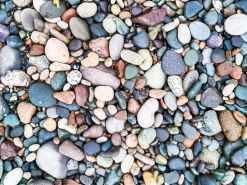Before you dig, check to see whether your soil is ready to be worked.
Working your soil when it is too wet creates big clumps, air pockets, and compacted areas.
Consider whether a no-till option will work well in your plot. (Again, see link above.)
Rocks
Some of our plots have a fair amount of rocks that you’ll want to remove before you plant. Please do not pile them at the edge of your garden, where they are hazardous when we mow; instead, use a bucket from our compost area to collect and discard them in the brush behind the composters.
For tips on planting seeds and transplants, see this tip sheet from UMassAmherst.
Your seed packet or plant tag will also have information on how to plant and space. If you are purchasing seedlings, ask if they’ve been hardened off. (See tip sheet for more info on hardening off.)
After you’ve planted, your garden will probably look sparse, but remember that your plants need room to grow and will fill in quickly. Every year I’m amazed by how different my garden looks at the end of the season.
Intensive gardening involves techniques that maximize yields in a given space.
Before I say anything else on this topic, I’ll mention first that intensive gardening requires a lot of planning. If you are just starting out in the garden, you may do better your first season by keeping things simple and planting with traditional guidelines.
Traditionally, crops are planted in straight rows with ample spaces between plants and rows. Most of the information that you’ll see on your seed packets and plant tags relies on traditional spacing guidelines. In many cases, you can fit more plants in your space than these guidelines indicate.
Certain plants in particular can handle some crowding. Peas, carrots, and radishes, for example, can be planted in bands, with rows of staggered seeds. My seed packet of Mini Mak radishes from Johnny’s instructs, “Sow in 2-3″ wide bands or single rows, seeds about 3/4 – 1″ apart (about 35 seeds/ft for bands and 15 seeds/ft. for single rows).” Based on this info, you can see how much more you can grow in a given space.
One of the simpler ways to make efficient use of our small plot area is to grow vertically. Consider growing pole beans, for example, instead of rows of bush beans
Another intensive practice includes successive plantings, which means harvesting one crop and immediately following with another. You might follow an early carrot harvest with a planting of bush beans. Or you might follow one harvest of bush beans with another. Interplanting involves fitting one crop within another’s space. Quickly-maturing radishes, for example, might be fitted among carrots and harvested first, freeing up space for the still-growing carrots.
Some plants don’t respond well to crowding. Tomatoes, for example, require a lot of space and are susceptible to diseases if not given adequate air flow. They’ll yield more if they are given sufficient room to spread. Still, you can maximize the number of tomato plants you can fit in an area by planting them in staggered rows.
Companion Planting
Companion planting is the idea that certain plants grown in combination with each other yield benefits. There is very little science backing up most companion- planting claims. For example, I often see the advice to plant marigolds as a pest deterrent, when in fact, there’s very limited evidence backing up this claim. Worse, in my own experience, marigolds draw Asiatic garden beetles, which strip both the marigolds and my basil plants. That’s not to say you shouldn’t plant marigolds if you like them or have had positive results with them in the past. There simply isn’t enough research to recommend them broadly as a pest deterrent.
Another popular example of companion planting is known as “Three Sisters.” In this case, corn is planted with pole beans and squash. The corn offers structural support for the climbing beans. Beans provide nitrogen for the heavy-feeding corn. And squash provides shade to help keep the soil moist.
Want a few other companion planting ideas? See this link.
Continued…
In case you missed it…
Part 1: Organic Gardening and Soil
